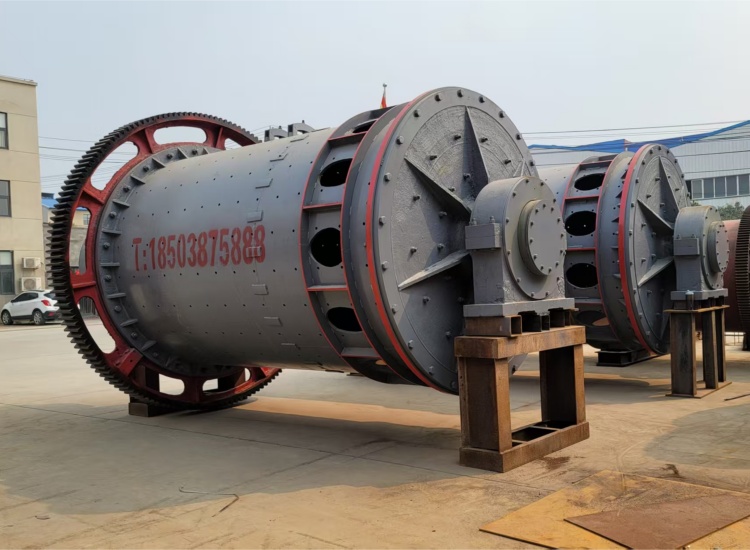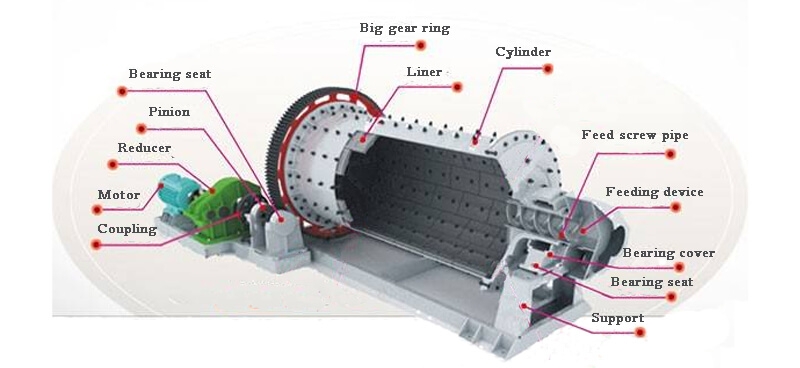MB series rod mills are widely used in metal and non-metal mines, water conservancy, glass and building materials departments to grind various ores, rocks and artificial sand, etc., which require uniform product particle size and less over-sand materials. The high-efficiency and energy-saving rod mills produced by our company all use rolling bearings to replace the bearing and sliding bearing support. Under the same working conditions, energy saving can be 10%-20% and production capacity can be increased by 10%-20%.
Overall dimensions: 0.9m-3.6m
Effective volume of cylinder: 1.15-50 m³
Rod loading:3-90 t
Cylinder speed:15-38 r/min
Power: 30-800 kw
Discharge size: 5-0.2 mm
Production:3-300 t/h
Weight: 6-200 t

The rod mill uses steel rods as grinding media and is in linear contact with the material. It has a strong selective crushing ability for the material during grinding, can accurately control the degree of material crushing, effectively reduce the phenomenon of over-crushing, retain the original characteristics of the material to the greatest extent, and improve product quality.
The steel rods are arranged and moved regularly in the cylinder, so that the material is evenly stressed during the grinding process, and the particle size distribution of the output product is concentrated and uniform, which can provide raw materials with stable particle size for subsequent industrial production.
The structural design is reasonable, which can adapt to larger feed particle size, can handle materials of various hardness, and has high production efficiency. It can meet the needs of large-scale production and play a key role in mining, building materials and other industries.
By adjusting the parameters such as the diameter, length, filling rate of the steel rod, the speed of the mill, and the feed amount, it can easily adapt to the grinding requirements of different materials. Whether it is ore, rock or artificial material, it can efficiently complete the grinding task.

<!-- Add remaining rows here... -->
| Model | Cylinder size (D×L) (mm) | Effective volume (m³) | Balls weight (t) | Rotary speed (r/min) | Power (kw) | Discharge size (mm) | Capacity (t/h) | Weight (t) |
|---|---|---|---|---|---|---|---|---|
| MB0918 | φ900×1800 | 0.85 | 2.3 | 38 | 22 | 5-0.2 | 6-1.6 | 6.2 |
| MB0924 | φ900×2400 | 1.15 | 3.1 | 38 | 30 | 5-0.2 | 10-2.9 | 6.6 |
| MB1224 | φ1200×2400 | 2.2 | 6.5 | 32 | 55 | 5-0.2 | 15-5 | 13.5 |
| MB1530 | φ1500×3000 | 5 | 8 | 27 | 75 | 5-0.2 | 20-5 | 16.7 |
| MB1830 | φ1800×3000 | 6.5 | 17 | 22.8 | 132 | 5-0.2 | 40-10 | 29.8 |
| MB2122 | φ2100×2200 | 6.7 | 18 | 20.9 | 160 | 5-0.2 | 80-10 | 42.5 |
| MB2130 | φ2100×3000 | 9.2 | 25 | 20.9 | 160 | 5-0.2 | 90-15 | 43.9 |
| MB2136 | φ2100×3600 | 11.0 | 28 | 20.9 | 200 | 5-0.2 | 100-20 | 49.4 |
Application fields:
Metal mines, non-metal mines, construction materials, artificial sand making, refractory material processing, chemical industry, water conservancy and hydropower industry, glass industry
Applicable materials:
Iron ore, copper ore, gold ore, quartz, diabase, dolomite, calcite, granite, basalt, sandstone, refractory materials, concrete aggregate, steel sand, slag, asphalt aggregate glass, etc.
Mining industry
Ore grinding: used to grind various ores mined, such as copper ore, iron ore, gold ore, etc., so that useful minerals and gangue minerals are fully dissociated, and provide raw materials of suitable particle size for subsequent mineral processing operations such as flotation, magnetic separation, and gravity separation, so as to improve the recovery rate of mineral processing.
Preparation of mineral powder: Grind the ore into fine powder to meet the requirements of subsequent processing technologies such as mineral powder sintering and pelletizing, so as to further refine metals or produce other mineral products.
Building materials industry
Cement production: Grind cement raw materials such as limestone, clay, and iron ore to achieve the specified fineness, provide qualified raw materials for the calcination and grinding process of cement, and ensure the quality and performance of cement. At the same time, in the cement grinding stage, rod mills can also be used to grind cement clinker with mixed materials such as gypsum into finished cement products.
Glass manufacturing: used to grind glass raw materials such as quartz sand and feldspar to make them uniform in particle size, which is conducive to the melting and clarification of glass and improves the quality and transparency of glass.
Chemical Industry
Grinding Chemical Raw Materials: Grinding various chemical raw materials, such as calcium carbonate, talcum powder, graphite, etc., to produce chemical products of different fineness, meeting the particle size requirements of fillers and additives in industries such as plastics, rubber, coatings, and inks.
Preparing Catalysts: In the production process of catalysts, rod mills can grind catalyst raw materials to increase the specific surface area of raw materials, improve the activity and selectivity of catalysts, and make chemical reactions more efficient.
Power Industry
Grinding Coal Powder: Grinding coal into coal powder provides fuel of suitable particle size for boiler combustion in thermal power plants, so that coal can be fully burned, improve power generation efficiency, and reduce energy consumption and pollutant emissions.
Other Industries
Ceramic Industry: Used to grind ceramic raw materials, such as kaolin, quartz, feldspar, etc., to prepare ceramic blanks with uniform particle size and stable performance, ensuring the quality and performance of ceramic products.
Refractory industry: Grind refractory raw materials such as bauxite and magnesia to produce refractory aggregates and powders that meet the requirements, which are used to manufacture various refractory bricks, refractory castables and other refractory products.
STCrushers provides high quality and reliable mining equipment customize manufacturing service for global customers, we design the production line according to the needs of the customer's processed materials and output, and realize fully automatic production from feed to discharge.
We have more than 20 years of experience in the production of large mining equipment.
We have an experienced production line design team to meet the processing needs of different materials.
We have two large workshops, a variety of processing equipment and machine tools.
The company strives to provide customers with preferential prices and payment methods to meet customer needs.
If you are looking for mining equipment such as stone crushers, ball mills, rotary dryer, rotary kiln and other equipment, feel free to contact us and our team will reply within 48 hours.